
 |
Eager Space | Videos by Alpha | Videos by Date | All Video Text | Support | Community | About |
|---|

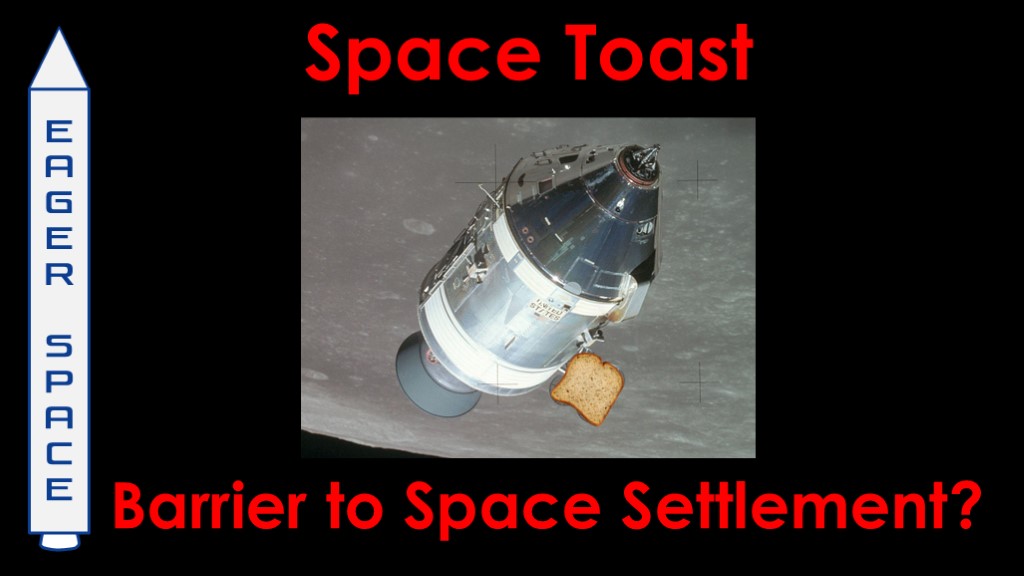
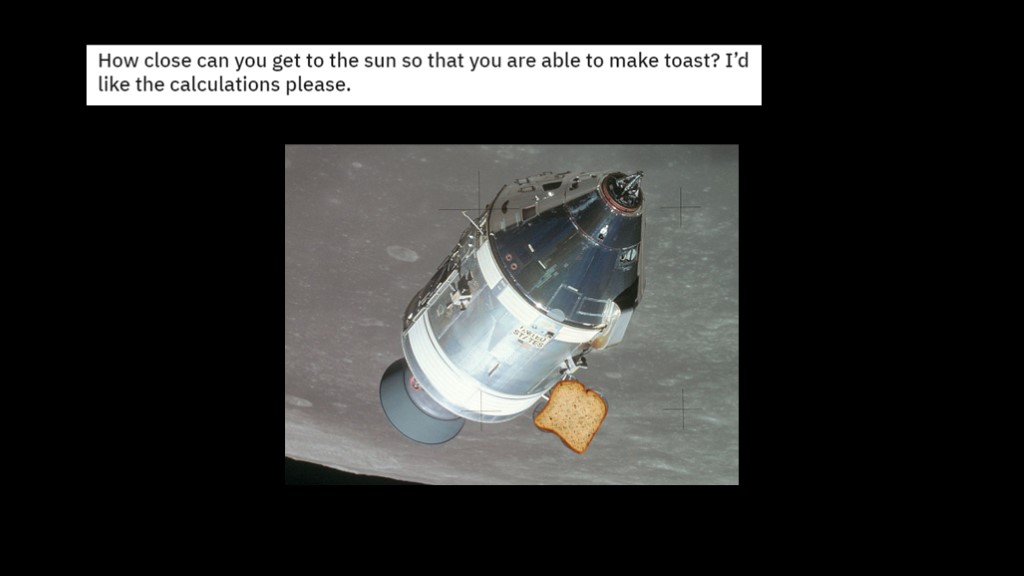
The expansion of space exploration and the transition to permanent space settlements will require us to answer many important questions which have so far been ignored by major spaceflight organizations worldwide.
Luckily, there are space enthusiasts to keep us on the right track, and one of them posed the following question:
"How close can you get to the sun so you are able to make toast? I'd like the calculations please."
If our primary and secondary space toasters both fail, can we use to the power of the sun to properly prepare out eggos, our pop-tarts, and our toast? And if so, what orbit would be optimal for these food preparations?
This is Space Toast...
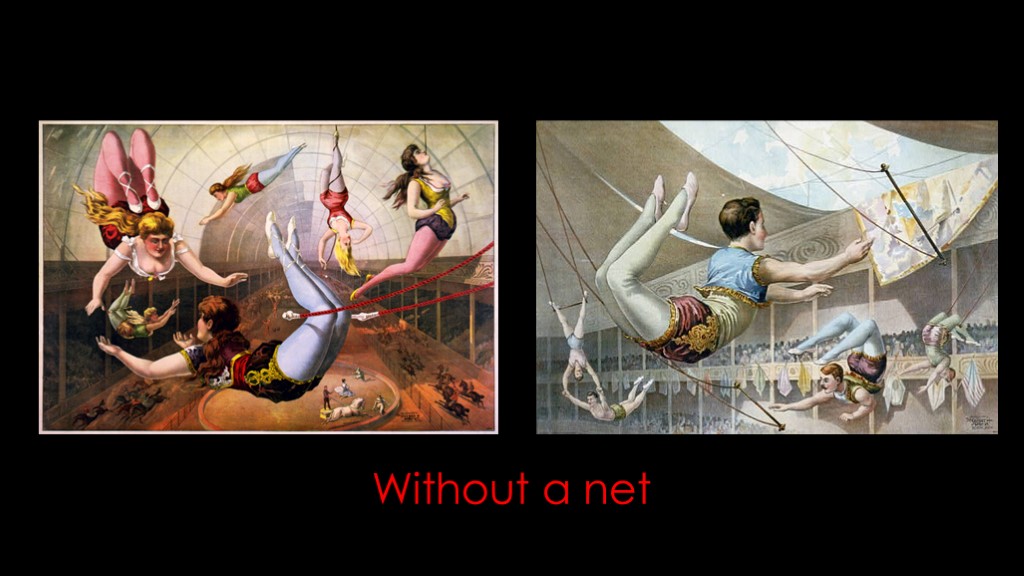
In the old days, some circus performances featured trapeze artists who worked without safety nets - where a fall would likely result in their death. "Working without a net" now means taking an action that is risky without using things that would provide safety.
I have decided to work without a net to answer this question.
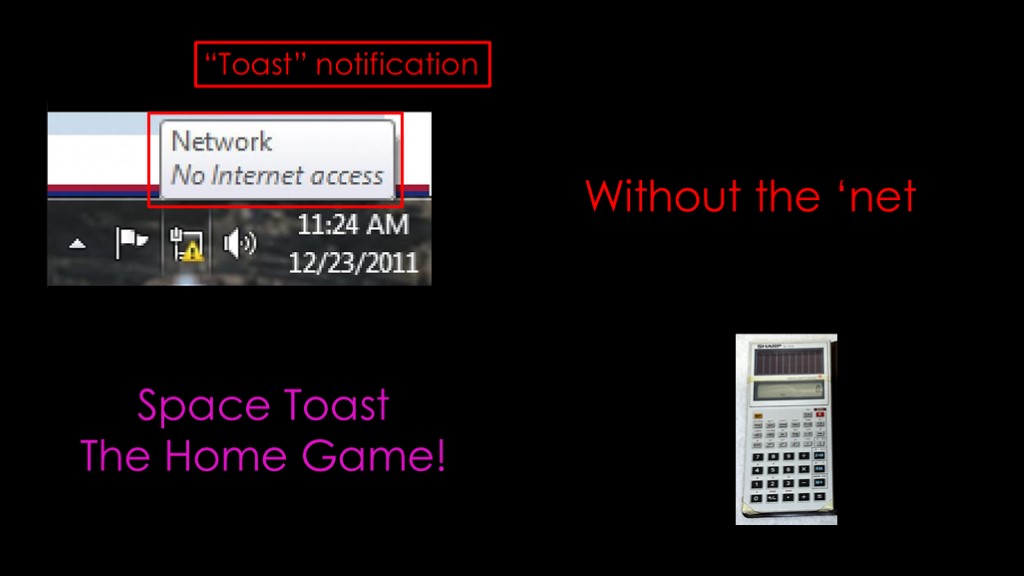
Or more specifically, without "the net".
I'm going to be doing this without using the internet to look anything up. I had originally planned to allow reference books but I looked around and we don't seem to own them any more, so those are out. And I'm going to try to avoid asking my PhD chemist wife for help. The goal is to see how far I can get using only what I've stored in my head.
If you want to join with me in my quest, pause the video and go do it and then come back and we can compare answers.
My answer will not have a high degree of accuracy; I'm going to be doing what used to be called "back of the envelope" calculations to get an answer that's pretty good. I did use an actual envelope leftover from a bill I got, but unfortunately I have misplaced it. I also used my Sharp EL-515 solar calculator that I bought for college in 1983.
There's a wonderful bit of synchronicity on this page. This little bit of UI that says there is no internet access is known technically as a "toast notification", which I view as a good omen in relation to my plan.
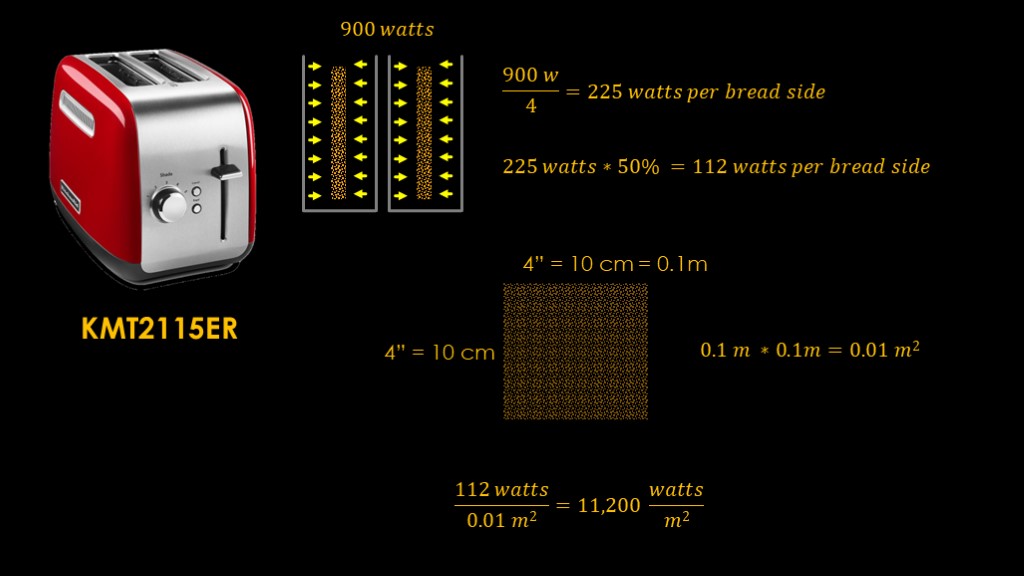
As a benchmark, I will be using a KitchenAid KMT2115ER toaster clad in the every popular empire red color scheme.
Looking at the nameplate, I see that the toaster pulls 900 watts of power. That is spread over two slices of bread that each have two elements, so that means each side of bread gets 225 watts of power.
The toaster uses nichrome wires to convert electrical energy to heat, and like few things around, it's 100% efficient, but not all that heat goes into the toasting process - put your hand above a toaster and you can easily feel the waste heat. I have no idea how much is wasted and I'm prohibited from using google scholar to find the latest bread-toasting research, so I'm just going to assume half the heat is wasted, and that gives us 112 watts per side of bread.
I know that I'm going to need to compare this to the power of the sun, which is generally measured in watts per square meter, so we'll need to scale that 112 watts up to a hypothetical toaster that can toast bread slices that are 1 meter square.
Bread is about 4" on each side, which is conveniently 10 cm or 0.1 meters. That makes the area 0.01 square meters, or 1/100th of a square meter.
We can divide 112 watts by the bread area, and if we do that, we get 11,200 watts per square meter.
Which honestly seems like a lot; a clothes dryer is something like 4000 watts of power and this is nearly 3 times that amount.
We now have enough information about the toaster.

We next need to figure out what we can expect from our dear old sun...
I remember from the video I did on solar power satellites that the power that reaches earth orbit from the sun is 1576 watts per square meter.
We can figure out the power ratio by dividing the toaster power by the solar power, and if we plug in the numbers we get about 7. A toaster puts 7 times the amount of energy into a piece of toast than the sun does.
At this point I can hear somebody complaining about the spectral differences between solar radiation and the heat the toaster is providing along with the differences between pure radiative heating in the vacuum of space and the heating of a toaster inside a spacecraft, and those are good points. Please incorporate those factors into your solution for this problem, and remember that you can only use what you currently have in your head. Make sure to show your work - you can earn up to 5 extra credit points doing this.

We'll need to get someplace closer to the sun for our space toaster to work, and that someplace will need to provide 7 times the radiation.
Time for some planetary math. The earth is 98 million miles from the sun, or about 157 million kilometers. We need to figure out where we need to be to increase the amount of received power by a factor of 7. It's obviously going to be closer to the sun, but how much closer?
At the orbit of the earth, all the sun's output goes through a sphere with a radius of 98 million miles, so we can simply calculate that surface area, divide it by 7, and then figure out the radius for that new area.
Unfortunately, the formula for the area of a sphere isn't something that is rattling around my brain, so that approach isn't going to help.
I do, however, remember that radiation obeys an inverse-square law. Get twice as far out, and the decrease in intensity will be 1 in 2 squared, or 1 in 4. Get closer, and increase follows the same law.
This equation describes it - the distance ratio that we want is equal to the square root of 1 over the intensity ratio.
Plug in our numbrers, and the square root of one 7th is 0.38.
Multiply it out, and we find that the intensity we want is at 37 million miles, which I hereby define as one KitchenAid of distance from the sun. I don't recall the distances of the other planets, but I do suspect that 37 million miles is well inside the orbit of Venus.
There is, of course a problem - our solar toaster only toasts one side of the bread.
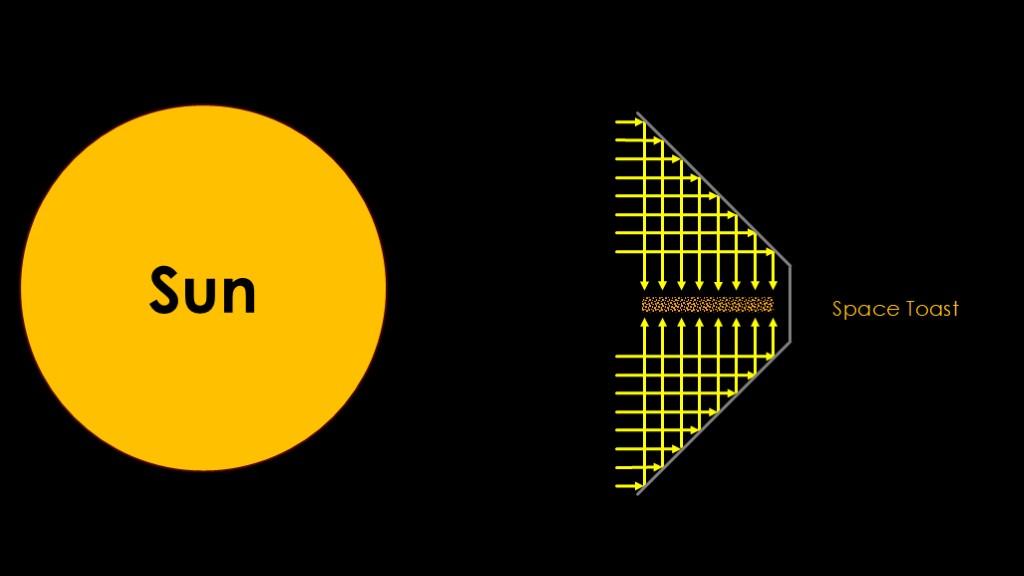
We can fix that problem quite handily with a little reflective magic, We put two mirrors at 45 degrees, and that allows us to reflect radiation and heat both sides of the toast at once.
And yes, the mirrors will reduce the heating slightly. Just make them a little bigger than they need to be and everything will be fine.
We've now answered our space toast question. Or have we?
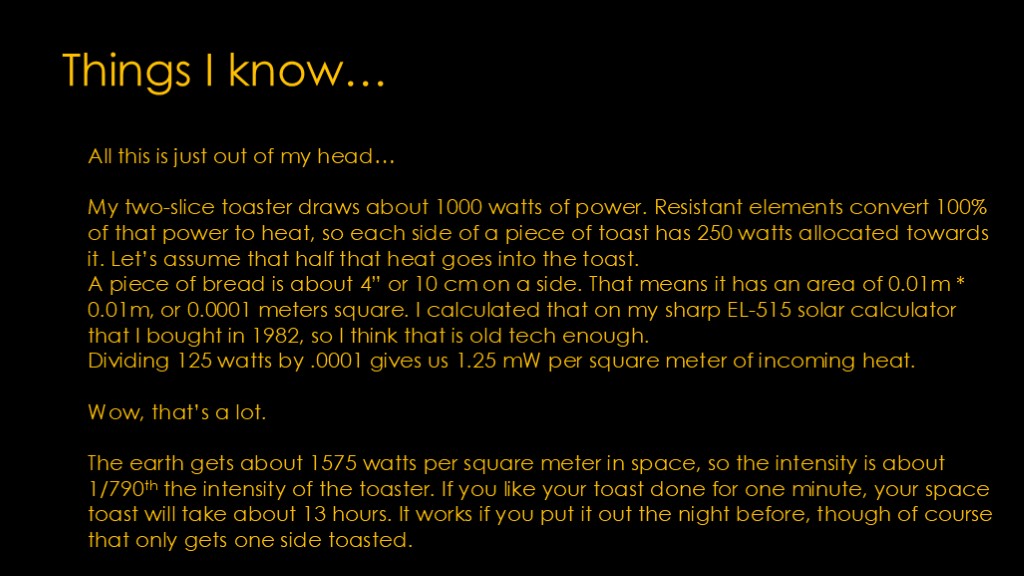
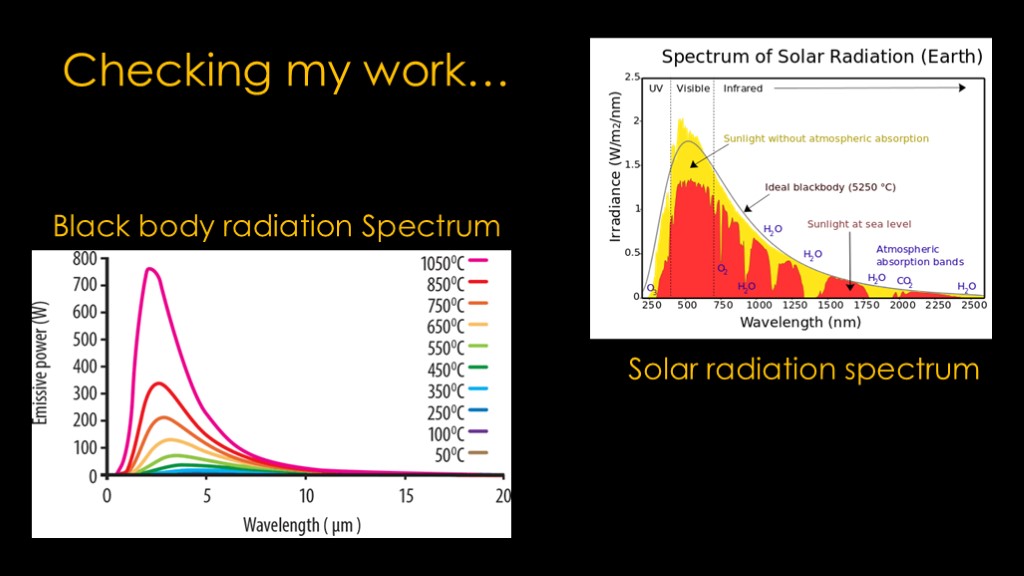
Time to check my work, and for this I will be using the internet.
First, if you want to do some analysis with different spectrums, the left is what you can expect to get with a nichrome wire in a toaster, which is probably around 1000 degrees centigrade.
The right one is the spectrum we get from the sun, which is pretty close to a blackbody at 5250 degrees centigrade.
Have fun figuring how to compare these.
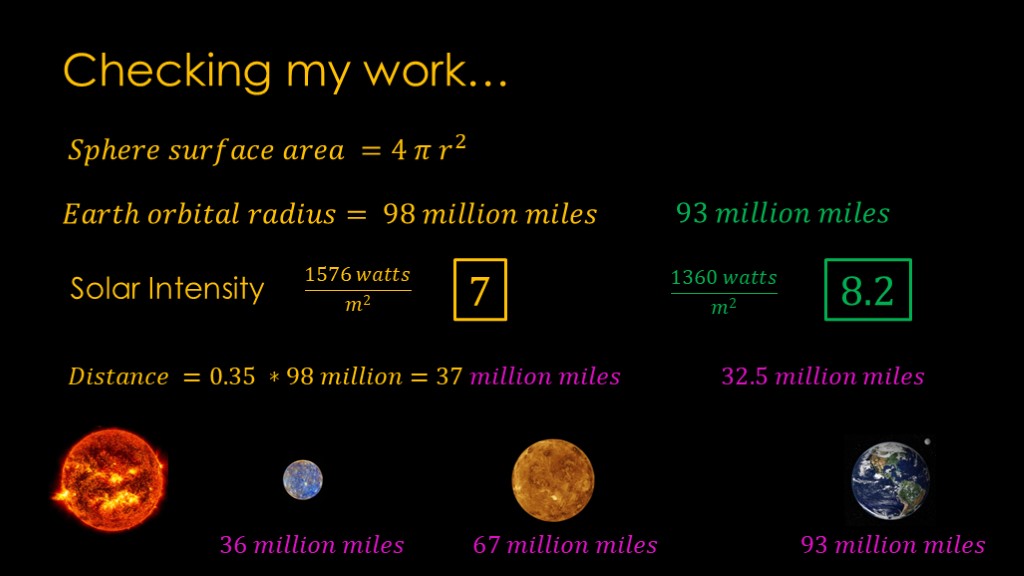
On to checking my work.
First, the surface area of a sphere is 4 times pi times the radius squared, which means my inverse square calculation was correct.
On the constants, I didn't do quite as well.
The earth's radius is 93 million miles, not 98 million miles. If I was smarter I would have calculated using astronomical units, where 1 is automatically the orbital radius of the earth, and that would have killed one constant.
I asserted that the solar intensity in orbit was 1576 watts when my notes from the solar power video notes tell me it's only 1360 watts per square meter. Our magic ratio then becomes 8.2 rather than 7.
Put those two changes together and that puts us at 32.5 million miles rather than 37 million miles. About 12% off.
Looking at the inner planets, we have the earth at 93 million miles, venus at 67 million miles, and mercury at 36 million miles, so the answer to the question is "about the orbit of mercury". That's where you want to get, and unfortunately it's a really long way from earth orbit.
You could simply leave your toast out 8.2 times as long, but note that as the toast heats up it starts radiating more energy so it takes longer than that. I also don't think you are willing to wait 15 minutes for a couple of slices of toast, but perhaps eggos are more important to your life than they are to mine.

If you enjoyed, this video, I am desperately in need the Dolce & Gabbana SMEG retro toaster collaboration, a steal at only $700.
It includes 6 toasting levels plus reheat, defrost, and bagel functions, and is purported to be the perfect morning assistant.